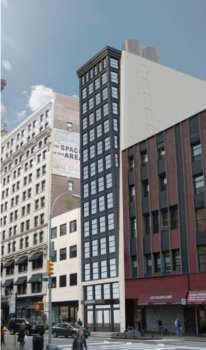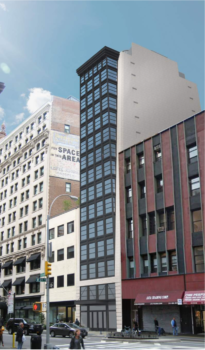
Rendering of the modified design for 1162 Broadway office building./Image Credit: Morris Ajemi Architects
The modified design received support from the majority of the Commissioners. On May 12, 2020, the Landmarks Preservation Commission voted to approve a Certificate of Appropriateness to construct a new 13-story office building on a vacant lot at 1162 Broadway, Manhattan. The vacant lot is located within the Madison Square North Historic District. In 2013, Landmarks originally approved the building’s construction and design for a new hotel but nothing was constructed. Morris Ajemi Architects, the building’s architectural firm, made slight modifications to the previously approved design.

Rendering of the 2013 building design./Image Credit: Morris Ajemi Architects
On December 17, 2013, Landmarks approved a design for a new 14-story hotel building that rose to a height of about 181 feet. In the original design, the building had a width of around 26 feet, making it a tall, slender building. There was a dark gray storefront with a matching painted awning on the ground floor. A beige glazed brick spandrel divided the ground floor storefront from the second floor. Four windows spanned across the width of the second to thirteenth-floor facade and six windows spanned across the width of the fourteenth floor. The windows were detailed with dark gray mullions and dark gray metal spandrels divided each floor. The building’s roof was lined by a dark gray cornice. The mechanical bulkhead, which included elevator and machine equipment, spanned the building’s roof. Two water towers, that rose to a height of around 18 feet, were on top of the elevator and machine equipment. On the sides of the building, there was a beige glazed brick sidewall that slightly slopes backward at the top and projected up to the bulkhead on the top of the building.
At the May 12, 2020 public hearing, Tom Lewis of Morris Ajemi Architects presented the modifications for a new office building. In the presentation, the office building design still had the majority of the same elements from the 2013 hotel design but there were slight changes. Lewis stated that the changes made to the original design include reducing the roof height by two feet, reducing the number of floors from fourteen to thirteen, changing the window wall system and making it thicker, and increasing the height of the windows by eight inches. He also stated that the bulkhead was removed and the elevator and machine equipment is now placed on only the north side of the building. Lewis explained that this was to reduce the visibility of the building. The height of the water towers was increased to 24 feet. The reduction in roof height and number of floors reduced the building’s overall height to around 185 feet.
The building’s thin design and its details are inspired by elements seen within the Madison Park North Historic District. The historic district consists of approximately 96 buildings that represent the City’s commercial history from the 1870s to the 1930s. Most buildings in the district are 20th century style office buildings, loft buildings, and rowhouses. The prominent architectural characteristics seen within the district include tall slender buildings that are over five feet and no more than 30 feet wide, projecting bay windows, metal storefronts, and the mixed-use of brick, steel, and metal for the building’s materials.
At the public hearing, Kelly Caroll testified on behalf of the Historic Districts Council. She stated that the Historic Districts Council believes that the design changes are appropriate but the water towers give the top of the building a lot of bulk and it should be lowered. In response, Tom Lewis stated that the increase of the water towers’ height was because the overall building height was lowered. He also mentioned that water towers are an iconic architectural feature seen in the City.
The Commissioners generally agreed that the modified design was appropriate and within the context for the historic district. Commissioner Jeanne Lufty stated that the tall thin building design is characteristic within the district and fits in well with the neighborhood. Vice Chair Frederick Bland and Commissioner Wellington Chen agreed with Tom Lewis and believed that the water tower is an iconic feature. However, Commissioner Everado Jefferson felt that the bulkhead added to the building’s design and believed that it should have remained.
Landmarks voted to approve the new design with the exception of Commissioner Jefferson who voted in opposition.
By: May Vutrapongvatana (May is the CityLaw Fellow and New York Law School Graduate, Class of 2019).

